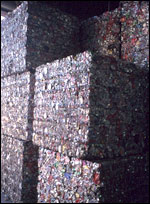Dear Umbra,
My friends and I consume a fair amount of beer, and we’re wondering: What’s worse for the environment, buying beer in cans or in bottles?
Kelly
Manitoba, Canada
Dearest Kelly,
Thank you for giving me a reason to look up the Earth’s mineral-reserves map in my atlas. I’ve learned fascinating things about aluminum and glass and discussed the whole matter with lifecycle analysis experts and recycling folks (including my pal Peke the recycling expert, who just biked over in freezing weather; let us all be inspired by Peke). The clear answer is: Drink locally bottled beer in glass bottles if you can.

Go ahead: Hit the bottle.
Bauxite, the source of aluminum, is the third most common element on our Dear Planet, making up 8 percent of the Earth’s crust. The amazing Hall-Heroult electrolytic smelting method of 1886 made aluminum available for the masses. In that process, bauxite is first scraped out of the Dear Planet’s crust, then refined into alumina. (Four kilos of bauxite yield two kilos of alumina.) The alumina is then mixed with cryolite and electrocuted. Chemistry magic occurs, the alumina breaks down into liquid aluminum, and that liquid is poured off into ingots. (Two kilos of alumina make one kilo of aluminum.)
The manufacture of aluminum is resource intensive and uses a stunning amount of energy: an average of 7.5 kilowatt-hours of electricity for each pound of virgin aluminum. Removing bauxite is no environmental picnic, either, what with the open-cast mining, the deforestation, the mud pits, and the building of roads into once-pristine areas. On the up side, virgin aluminum is 100 percent recyclable. Making new cans from old ones requires as little as 5 percent of the energy needed to make new cans from bauxite. In the U.S., aluminum products generally contain 35 percent recycled content. Those numbers look good, don’t they? I look small when I stand next to an elephant, too. Aluminum production costs are gargantuan, dwarfing recycling costs. Recycle those cans, folks.
Virgin glass beverage containers are also made from an abundant natural material: sand, mixed with limestone. Extracting any resource removes part of our Dear Planet, shifting the environment for good or, more commonly, ill, and sand is no exception. But the transformation of sand into glass is easier and less energy intensive than the laborious journey from bauxite to aluminum. Just get that sand really, really hot and it’ll melt into a beautiful glass beer bottle. Glass is recyclable, as you know, although the market for glass recyclables varies widely by location.

Cans get a new lease on life at an aluminum recycling plant.
The finicky answer to your can-vs.-bottle dilemma is that it depends how far the packaging materials were shipped when raw, empty, and filled. The energy costs of producing aluminum would make glass clearly preferable, if glass weren’t so darn heavy. Lightweight aluminum may have equal or better freight costs even if it is shipped farther. However, moving glass is expensive (environmentally and financially), so it’s more likely to be kept in a regional waste stream. You see how easy it is to go insane in an attempt to do the right thing. Learning the travel history of a brew container is a lot to ask of the average drinker. If you have a decent local glass recycling program, go with glass.
In the perfect situation, your local brewer would be reusing bottles. And maybe they are. Check around. But don’t worry too much. Your beer can is just one of many uses for aluminum (and a rather small one, at that): Cars, buildings, airplanes, and more are all made with aluminum parts. And, of course, glass is also popular among the object-making businesses. So if you must worry, worry about the aluminum that went into your automobile, and make it last as long as you can. (Get it, can? Har har.)
Tinly,
Umbra

